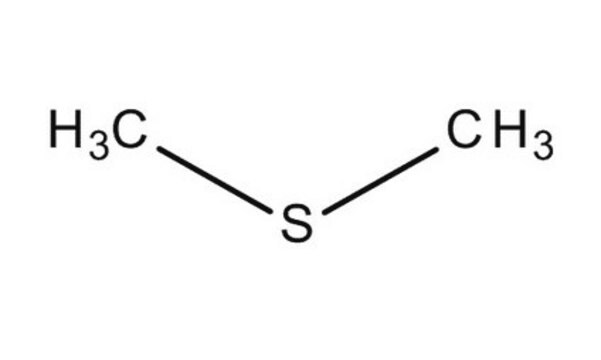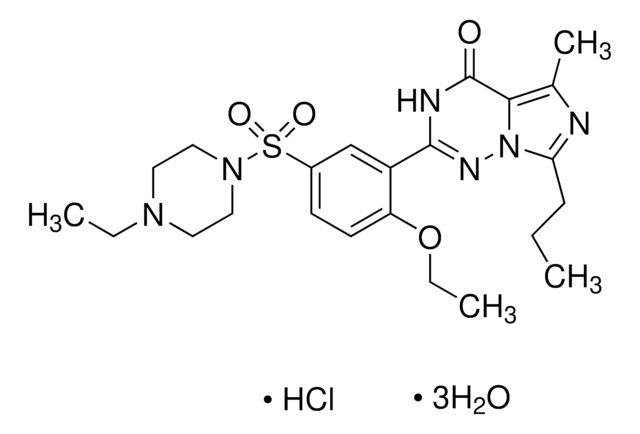471577
Dimethylsulfid
≥99%
Synonym(e):
DMS, Methylsulfid
About This Item
Empfohlene Produkte
Dampfdichte
2.1 (vs air)
Qualitätsniveau
Dampfdruck
26.24 psi ( 55 °C)
7.79 psi ( 20 °C)
Assay
≥99%
Selbstzündungstemp.
402 °F
Expl.-Gr.
19.7 %
Brechungsindex
n20/D 1.435 (lit.)
bp
38 °C (lit.)
mp (Schmelzpunkt)
−98 °C (lit.)
Löslichkeit
water: soluble 7.28 g/L at 20 °C
Dichte
0.846 g/mL at 25 °C (lit.)
SMILES String
CSC
InChI
1S/C2H6S/c1-3-2/h1-2H3
InChIKey
QMMFVYPAHWMCMS-UHFFFAOYSA-N
Angaben zum Gen
rat ... Maoa(29253) , Maob(25750)
Verwandte Kategorien
Allgemeine Beschreibung
Anwendung
- Characterization of the aroma-active compounds in Xiaokeng green tea by three pretreatment methods combined with gas chromatography-olfactometry (GC-O).: This study identified and characterized the aroma-active compounds in Xiaokeng green tea, highlighting the significant role of dimethyl sulfide as a contributor to its unique aroma profile (Gan et al., 2024).
- Novel insights into dimethylsulfoniopropionate cleavage by deep subseafloor fungi.: This article provides new insights into the metabolic pathways of deep-sea fungi, focusing on the cleavage of dimethylsulfoniopropionate (DMSP) and subsequent production of dimethyl sulfide, impacting sulfur cycling in marine ecosystems (Liu et al., 2024).
- Adsorption Mechanism and Regeneration Performance of Calcined Zeolites for Hydrogen Sulfide and Its Application.: The study explores the use of calcined zeolites for the adsorption of hydrogen sulfide, a precursor to dimethyl sulfide, and discusses the material′s regeneration performance for industrial applications (Zha et al., 2024).
Signalwort
Danger
H-Sätze
Gefahreneinstufungen
Flam. Liq. 2
Lagerklassenschlüssel
3 - Flammable liquids
WGK
WGK 1
Flammpunkt (°F)
-32.8 °F - closed cup
Flammpunkt (°C)
-36 °C - closed cup
Persönliche Schutzausrüstung
Eyeshields, Faceshields, Gloves
Hier finden Sie alle aktuellen Versionen:
Analysenzertifikate (COA)
Die passende Version wird nicht angezeigt?
Wenn Sie eine bestimmte Version benötigen, können Sie anhand der Lot- oder Chargennummer nach einem spezifischen Zertifikat suchen.
Besitzen Sie dieses Produkt bereits?
In der Dokumentenbibliothek finden Sie die Dokumentation zu den Produkten, die Sie kürzlich erworben haben.
Kunden haben sich ebenfalls angesehen
Unser Team von Wissenschaftlern verfügt über Erfahrung in allen Forschungsbereichen einschließlich Life Science, Materialwissenschaften, chemischer Synthese, Chromatographie, Analytik und vielen mehr..
Setzen Sie sich mit dem technischen Dienst in Verbindung.









